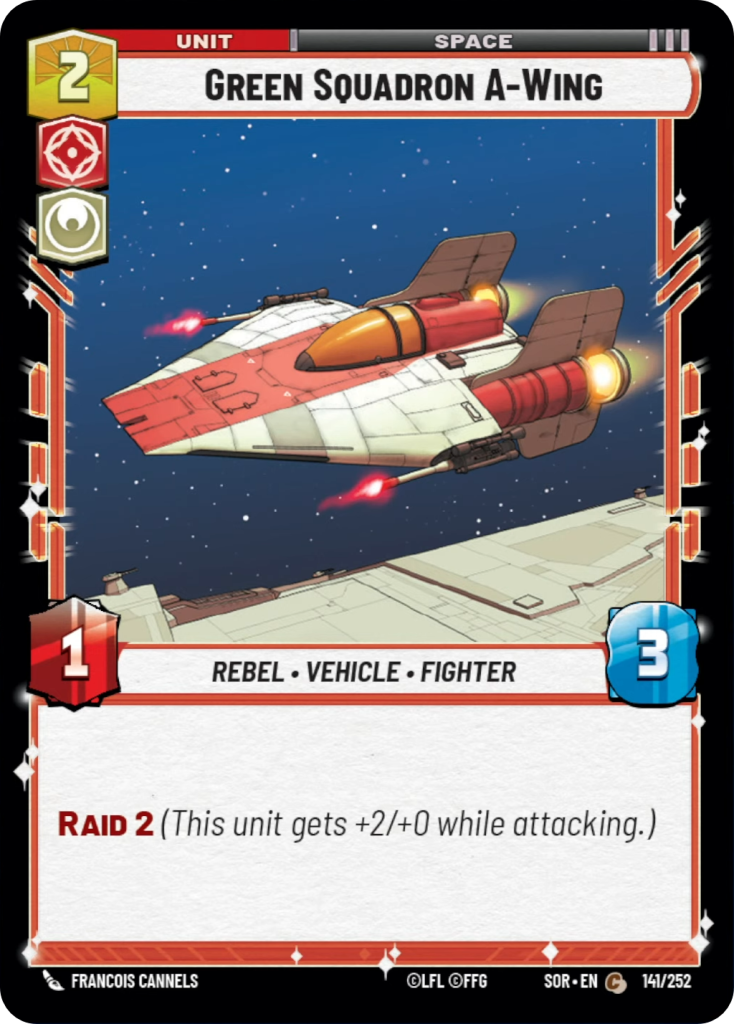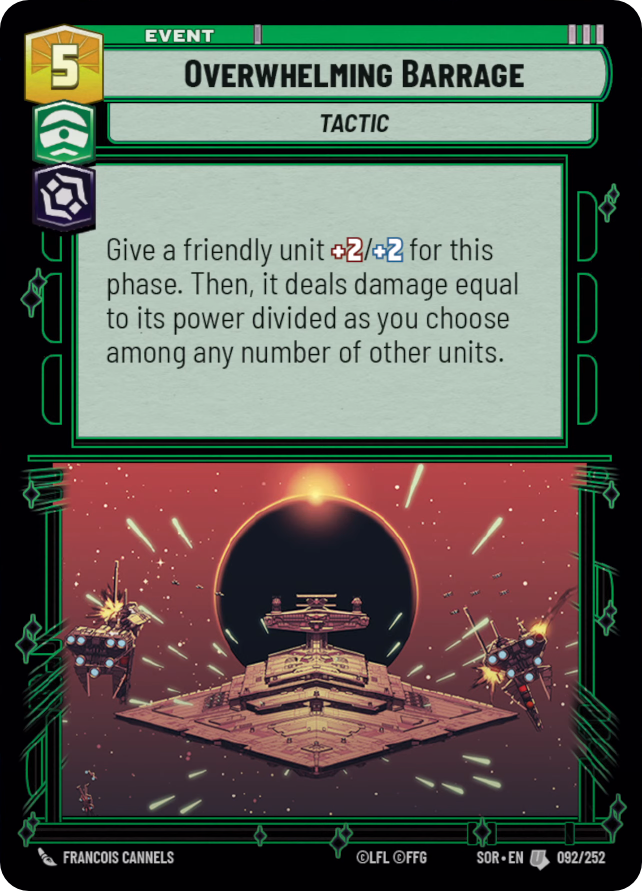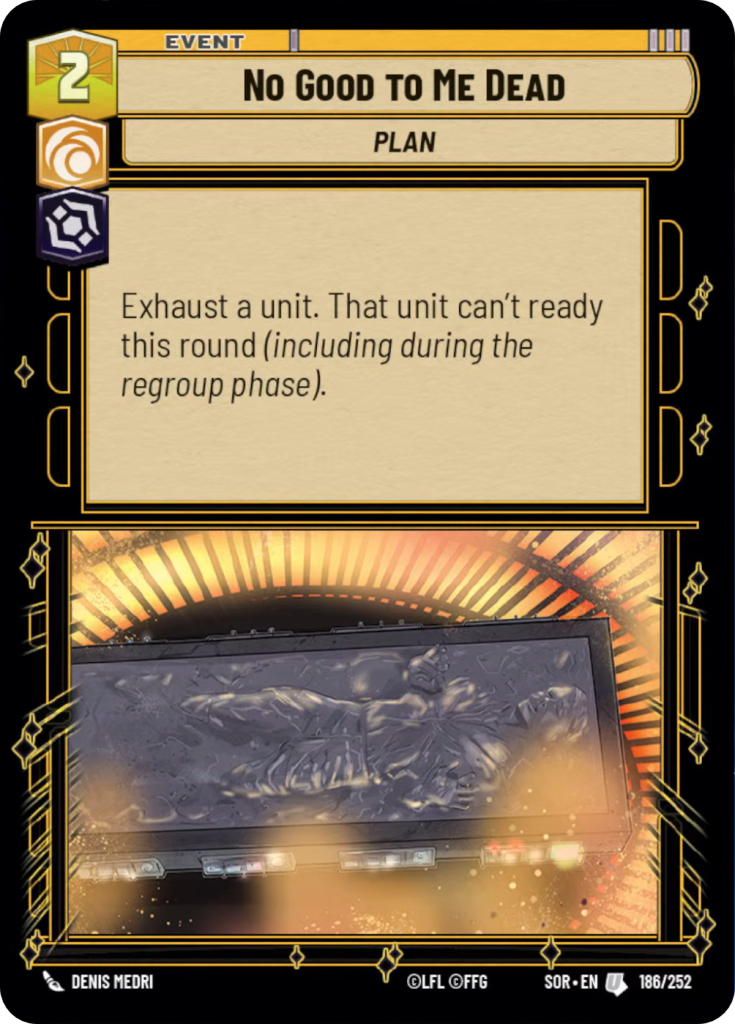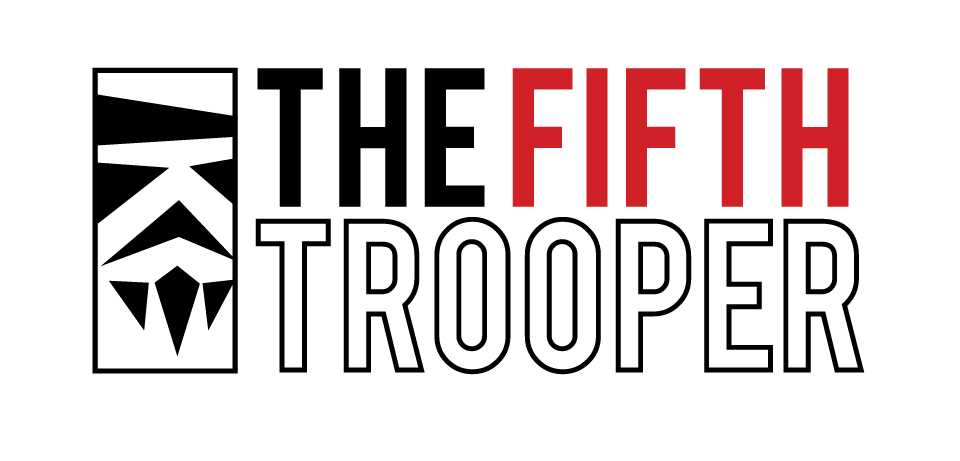Star Wars Unlimited Deckbuilding and Aspects
Welcome back to The Fifth Trooper’s coverage of Star Wars: Unlimited TCG! Last time, we went over a general introduction to the game. This time, I’m going to focus on discussing the process of building a deck and what choices are involved there, as well as going into more detail on what the different aspects do.
Perhaps the two most important choices in Star Wars Unlimited deckbuilding are what leader you want to play as and which aspects you want to include in your deck. These choices have a huge influence on the other cards available to you — while you can include cards from any aspect in a deck, cards played without the appropriate aspect icon will cost two more resources for each aspect icon they are missing. This cost generally — though not always — makes running out of aspect cards unworkably inefficient — the main exception is scenarios where the out of aspect card provides a critical capability that you can’t get within your aspects.
In general, though, you’ll be mostly (or entirely) selecting cards that match the aspects you included with your leader and base. This isn’t just an aesthetic choice based on which color you think looks best, though — the cards available in those aspects have pretty different styles of play and therefore can have a big impact on how your deck plays. As I mentioned in my previous article, Star Wars Unlimited has four “neutral” aspects — Aggression, Command, Cunning, and Vigilance — and two “moral” aspects, Heroism and Villainy. Let’s go into more detail as to what those aspects do for you based on what we’ve seen in Fantasy Flight Games’s preview content thus far.
Aspect Highlight: Aggression
We’ll start with Aggression. Aggression (red) is an aspect focused on damage, damage, damage! Aggression decks may appeal to players who like pushing damage to the enemy. Most units in Star Wars Unlimited have more HP than they do power (or perhaps equal HP and power) but Aggression has some notable exceptions, with cards like Death Star Stormtrooper or Star Wing Scout having poor defense but lots of offense.

This Star Wing Scout also shows one of Aggression’s subthemes — “initiative matters”! Some Aggression cards have advantageous effects when you have the initiative, while others are stronger when they’re attacking and weaker on defense. This makes having the initiative quite important with Aggression decks, and one of the things that can make piloting them more complicated is managing the initiative.
For example, Sabine Wren, Galvanized Revolutionary — currently perhaps the best leader in the game for an aggro deck — has an ability on her leader side that can get you more damage on the enemy base every turn, but using it takes an action for a relatively low-impact effect. Sabine players should be careful to evaluate whether using this ability is worth potentially losing the initiative.
Aggression also has direct damage-based “burn” removal with cards like Open Fire. However, unlike “burn” cards in some other games, Aggression’s direct damage cards generally only damage units, not the enemy base. That said, Aggression does also have some cards that can push direct damage onto the enemy base without attacking, though generally in small amounts — various cards we’ve seen, like the Sabine Wren leader linked earlier or the Fighters for Freedom, have “ping” effects that can do one damage to the enemy base under certain circumstances.

The chief weakness of Aggression cards that you should consider taking into account in Star Wars Unlimited deckbuilding is weak defenses. This can come either in the form of cards with low HP or either with cards that are much stronger on offense rather than defense. In theory, you can avoid this by being fast and aggressive enough that it doesn’t matter, but in a protracted engagement with lots of fighting between units, Aggressive units can suffer.
For example, this Green Squadron A-Wing (currently one of the best two-cost units we’ve seen previewed) doesn’t have low HP, but it relies on the Raid keyword to do major damage — on defense, it’s much more vulnerable and various other ships can trade favorably with it, especially given that the 3/2 statline is common in space!

In Star Wars Unlimited deckbuilding, Aggression is a great choice if you like doing damage — it has some of the best and most straightforward “direct damage” cards in the game, which can mean a lot! Players who played red in Magic: the Gathering may find Aggression an appealing aspect to run with.
Aspect Highlight: Command
Our next “neutral aspect” is Command. Command is the “endgame aspect”, with a lot of focus on ramp (effects that permanently grant extra resources), powerful late-game cards to play once you’ve ramped up, and healing for your base to keep you alive while you’re waiting for those heavy hitters! If you want to use the biggest, toughest units in the game — especially in space — Command may be the aspect for you.
Ramp effects can pair especially well with powerful but slow to deploy leaders like Darth Vader, Dark Lord of the Sith — when your leader is going to arrive late but hopefully make a big splash, hurrying that up with cards like the classic Resupply can be quite a powerful move! And while ramp cards are often less relevant once your leader has hit the field, they can still be used to accelerate you towards Command’s powerful endgame units!

Speaking of endgame units, if you like big battleships, Command is the aspect for you! Cards like Home One, Alliance Flagship or Relentless, Konstantin’s Folly can be powerful “game enders” if unanswered. But it’s not just the space arena where Command brings huge units — ground units like 97th Legion, Keeping the Peace on Sullust or Blizzard Assault AT-AT can pack quite a punch as well! In fact, of the six currently-previewed units that cost eight or more as of this writing, two-thirds of them have the Command aspect — including our biggest unit to date, the mighty Devastator, Inescapable!

But a deck with just big endgame stuff is likely to get overwhelmed before it can get everything in place, ramp or no ramp — fortunately, Command has several tools to try and get things under control, including units that can heal your base like Colonel Yularen, ISB Director, cards that can be played early game to help hold off the enemy and become stronger later (like Seasoned Shoretrooper), and even the probable best removal card we’ve seen in the game thus far — the infamous Overwhelming Barrage, which allows you to do huge damage once you have a powerful unit in play, stabilizing the board!

One weakness of Command is that its removal options are comparatively limited and rely on having units already in play — as strong as Overwhelming Barrage may be, it doesn’t help if you don’t have a strong unit to boost your attack! Similarly, Admiral Ackbar, Brilliant Strategist requires other units already in play to do a lot of damage with his effect. This means that Command decks can sometimes get overwhelmed — if the opponent sends in lots of units and you don’t have a board yourself, your removal might not work!
Ultimately Command seems especially well-suited in Star Wars Unlimited deckbuilding for those who like playing big units and having strong endgame plays. The Command aspect’s ramp also works well with later-game leaders like Vader, while it doesn’t get quite as much value with leaders that deploy early. Players who like Magic: the Gathering’s ramp and big creatures from green might feel right at home playing Command!
Aspect Highlight: Cunning
Next up, let’s take a look at the Cunning aspect and what it brings to the table. Cunning, like the name perhaps suggests, is an aspect with lots of tricks and surprises to bring to the table. Players who decide to play Cunning will have access to the most “combat tricks” (cards that allow a unit to attack with a buff), as well as other disruptive and surprising cards — even ones that discard cards from the opponent’s hand!
Unlike other aspects, Cunning doesn’t have direct removal. However, its combat tricks can allow your units to clear out enemies more efficiently than others. For instance, Surprise Strike is a classic Cunning combat trick, allowing a unit to attack with +3 power. This can be a great card for getting the bonus damage needed to attack and defeat an enemy leader in one shot, to inflict the final blow on the enemy base, or just to have a unit “punch above its weight”!

Cunning also has many ways to exhaust or bounce enemy units, which is a form of “soft control” — while it doesn’t remove the enemy unit altogether, it can at least lock them down for the time being, buying time for you to put together another response — or just try and push more damage to the enemy base and win the game!
One of the strongest examples of this is the recently-previewed No Good to Me Dead. This card not only exhausts a unit, it prevents them from readying this turn — and because this applies to the regroup phase as well, the targeted unit won’t ready at the end of the turn and therefore will be exhausted during the next turn of the game as well! This effect can even be used on the enemy leader, which can quite dampen the impact of a powerful leader deploying onto the board!

Further, Cunning has a lot of units with the Ambush keyword, allowing them to ready and attack an enemy unit (but not a base!) as soon as they are played! These units work well with the overall “surprise” theme that Cunning has to offer players in Star Wars Unlimited deckbuilding, giving you more ways to deal with enemy units that are difficult for an opponent to predict.
Cunning also has a few units that go one step further — rather than getting to ready and attack a unit, these simply come into play ready in the first place! This is usually not quite as good as Ambush against units (since your opponent will get a chance to take an action before you can attack, potentially stopping your unit or getting value out of a target before it can be defeated), but it does allow you to attack enemy bases on the turn you play your card! Here’s Millenium Falcon, Piece of Junk, for instance:
The main weakness of Cunning in Star Wars Unlimited deckbuilding is that a lot of its solutions are “short term”. Cunning doesn’t really have hard removal — you can exhaust and bounce enemy units, but that doesn’t actually get them permanently gone! Similarly, Cunning has resource acceleration, but not permanent ramp — you might be able to ready a resource or get a “bonus resource” for a turn, but unlike Command’s ramp effects those boosts only last for a turn.
These factors make Cunning pair especially well with Aggression in my experience with Star Wars Unlimited deckbuilding — an Aggression deck that wants to close out the game fast can really benefit from Cunning’s “short term” tricks to try and buy the time it needs. However, other aspects can also benefit from Cunning — sometimes, aggro or not, you just want to have a hand full of tricks to confound your opponent with!
Aspect Highlight: Vigilance
Last but not least of the “neutral aspects” is Vigilance. This aspect focuses on defensive and control-oriented play. If you hear “Star Wars Unlimited deckbuilding” and your thoughts immediately turn to “What can I use to play control?”, Vigilance might be the aspect for you.
Vigilance has lots of cards with Sentinel or Restore, allowing you to stave off aggressive opponents by constraining their attack options or healing damage from your base. Restore in particular often comes quite cheaply, with cards that are basically on curve also having some healing abilities. The classic Restored ARC-170, for instance, combines solid stats for its cost with Restore 1, allowing you to get extra value by repairing your base against an opponent who is “racing” — or perhaps one who controls the ground arena while you have the advantage in space.

Additionally, Vigilance is the aspect with the most access to Shield tokens from what we’ve seen. Shield tokens allow units to absorb incoming damage, no matter how strong, and Vigilance’s use of these tokens can be very difficult to deal with, especially when combined with the Sentinel units described earlier!

Further Vigilance has perhaps the premier removal cards in the game, or at least the most reliable ones — unlike the damage-based effects that other aspects have to offer, Vigilance has cards that defeat enemy units directly. This means that Vigilance’s control cards “pierce Shields” — since Shields block damage but not direct defeat effects, they don’t help against cards like Takedown or Vanquish!

One weakness of Vigilance is that it isn’t a very aggressive aspect. Vigilance units often have more health than they do power and/or come with less efficient stats in favor of defensive abilities. This can be useful when you’re trying to hold off aggressive opponents, but when it comes time to take the fight to the enemy Vigilance may not be the best aspect. However, players can potentially mitigate this either by pairing Vigilance with another aspect that has better options on the offense — like Aggression or Cunning — or else by leaning into the defensive angle and playing for the endgame with big Command battleships to close things out.
Overall, Vigilance is a great aspect to choose in Star Wars Unlimited deckbuilding if you like some more defensive and control-oriented gameplay — it couples tools for keeping your base safe, resilient units, and premier removal options for dealing with enemy threats.
Aspect Highlight: Heroism and Villainy
The last two aspects are the “moral aspects”, Heroism and Villainy. These are different from the “neutral” aspects in that they cannot be provided by bases, just by leaders, and are mutually incompatible — there is currently no way to have both Heroism and Villainy aspect icons in a deck, though you could still splash in out-of-aspect cards and pay the aspect penalty when playing them.
Heroism and Villainy have a lot of “parallel” cards to one other. Cards like Wing Leader and TIE Advanced, Fleet Lieutenant and Snowtrooper Lieutenant, or General Dodonna, Massassi Group Commander, and General Veers, Blizzard Force Commander provide fundamentally similar effects.
However, once Heroism and Villainy are paired with other aspects, things can get more divergent. For example, both sides of the Command aspect focus on abilities that are based on having units on board, but Command Villainy rewards you for “going tall” with individual large units, while Command Heroism focuses more on “going wide” with many smaller units — see for instance Admiral Ackbar, Brilliant Strategist, who provides a removal effect that scales not with unit power but with number of units:

Overall, one’s choice of Heroism or Villainy in Star Wars Unlimited deckbuilding largely tied to what leader you want to play, and both of these aspects offer at least somewhat similar options, though they aren’t exact parallels — in addition to things like the “wide versus tall” factor that I described before, Villainy currently has access to significantly more removal than Heroism and to stronger “endgame units”, while Heroism has some of the best early game units out there. (Of course, this could easily change as we see more cards previewed…)
Further Star Wars Unlimited Deckbuilding Tips
With the aspects now covered, you might have an idea of which appeal to you. Once you’ve picked a leader and base, you can dive into deckbuilding proper. There’s a lot that could be said on the topic of Star Wars Unlimited deckbuilding, but here are some general tips for this:
- In general, the 25 HP bases with Epic Actions seem stronger than the 30 HP bases without activated abilities. I would recommend starting with a leader that seems cool to you and then one of the Epic Action bases in the aspect of your choice.
- It’s often important to have a solid core of one to two cost units, as you will generally want to play at least one of these units on the first turn. Nine of these units often feels like a “minimum” to me, and I often play more.
- It’s good to have some idea of what your deck wants to do. For example, are you trying to be aggressive early on? If so, you probably want cheaper and more aggressive cards. Are you playing for the long game? If so, you probably want ramp cards and large endgame units.
- Try to keep your deck to the fifty-card minimum. This is a standard method in card games of this type — you want your deck to be as small as allowed so as to maximize your chances of drawing your best cards.
- “Double aspect” decks, which use the same aspect twice, are cool but not particularly strong right now (though this could change with more cardpool) — in general, getting access to a strong double aspect card and benefiting more from same-aspect synergies isn’t worth losing access to an entire aspect’s worth of options.
- Aiming for something like 30-40 units and 10-20 non-unit cards in a 50 card deck seems like a reasonable starting point — while events and upgrades can be strong, it can be risky to take too many of them and potentially end up without solid units to play. At the same time, you want to have at least some tricks rather than just a bunch of units to deploy.
- Most decks should likely include a mix of ground and space units. While ground units are often somewhat more efficient stat-wise, letting your opponent easily control space can be very dangerous. Similarly, when thinking about removal options it’s important to have cards to answer enemy units in both arenas. Note also that all currently known Space units are Vehicles, so cards that don’t work on Vehicles (like Force Choke) can’t affect space targets even though it doesn’t say that directly — perhaps in the future there will be space creatures of some kind that Force Choke is effective against?
- Some cards have trait synergies, like the Lieutenants mentioned earlier. These cards can be very strong in the right situation, but become notably less effective the more units you have that don’t have the matching trait. For example, Maximum Firepower is likely not going to be an effective card if you only have a few small Imperial units in your deck.
Lastly, it’s okay not to know where a deck is going to end up, to experiment with cards that you are curious about, and so on! Star Wars Unlimited deckbuilding has a lot of options on offer, and sometimes it makes sense to just throw together some things you’re interested in and give it a whirl! Having played some games, you’ll be in a better place to evaluate which cards have been working well for you and which haven’t.
Hopefully, this article has given you some ideas of where to start in Star Wars Unlimited deckbuilding and what aspects may especially appeal to you. I find it a remarkably positive sign that this game already has quite interesting deckbuilding options available with only a bit more than half the cards previewed — as we get closer to launch, the available options are only going to expand further, and I for one am quite excited to see what the future holds in this area!
